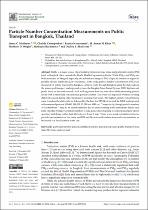| dc.contributor.author | Shallcross, Dudley E | |
| dc.contributor.author | Matthews, James C | |
| dc.contributor.author | Chalida, Chompoobut | |
| dc.contributor.author | Navasumrit, Panida | |
| dc.date.accessioned | 2024-01-25T14:01:28Z | |
| dc.date.available | 2024-01-25T14:01:28Z | |
| dc.date.issued | 2023 | |
| dc.identifier.citation | Matthews, J.C., Chompoobut, C., Navasumrit, P., Khan, M.A.H., Wright, M.D., Ruchirawat, M. and Shallcross, D.E., 2023. Particle number concentration measurements on public transport in Bangkok, Thailand. International Journal of Environmental Research and Public Health, 20(7), p.5316. | en_US |
| dc.identifier.uri | https://doi.org/10.3390/ijerph20075316 | |
| dc.identifier.uri | http://hdl.handle.net/10566/9268 | |
| dc.description.abstract | Traffic is a major source of particulate pollution in large cities, and particulate matter (PM) level in Bangkok often exceeds the World Health Organisation limits. While PM2.5 and PM10 are both measured in Bangkok regularly, the sub-micron range of PM, of specific interest in regard to possible adverse health effects, is very limited. In the study, particle number concentration (PNC) was measured on public transport in Bangkok. A travel route through Bangkok using the state railway, the mass rapid transport underground system, the Bangkok Mass Transit System (BTS) Skytrain and public buses on the road network, with walking routes between, was taken whilst measuring particle levels with a hand-held concentration particle counter. The route was repeated 19 times covering different seasons during either morning or evening rush hours. | en_US |
| dc.language.iso | en | en_US |
| dc.publisher | Multidisciplinary Digital Publishing Institute (MDPI) | en_US |
| dc.subject | Aerosol | en_US |
| dc.subject | Bus | en_US |
| dc.subject | Particulate matter | en_US |
| dc.subject | Personal exposure | en_US |
| dc.subject | Public transport | en_US |
| dc.title | Particle number concentration measurements on public transport in Bangkok, Thailand | en_US |
| dc.type | Article | en_US |

